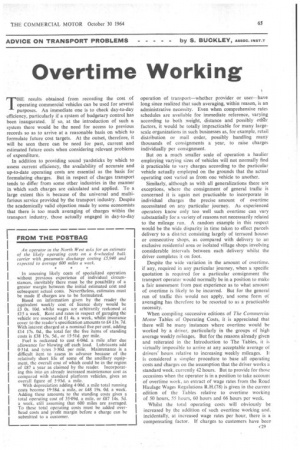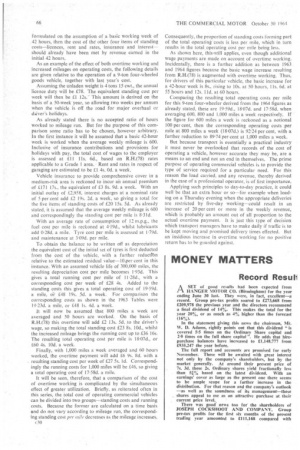Overtime Working
Page 67

Page 68

If you've noticed an error in this article please click here to report it so we can fix it.
THE results obtained from recording the cost of operating commercial vehicles can be used for several purposes. An immediate one is to check day-to-day efficiency, particularly if a system of budgetary control has been inaugurated. If so, at the introduction of such a system there would be the need for access to previous records so as to arrive at a reasonable basis on which to formulate future cost targets. At the outset, therefore, it will be seen there can be need for past, current and estimated future costs when considering relevant problems of expenditure, In addition to providing sound yardsticks by which to assess current efficiency, the availability of accurate and up-to-date operating costs are essential as the basis for formulating charges. But in respect of charges transport tends to differ from some other industries in the manner in which such charges are calculated and applied. To a large extent this is because of the universal and multifarious service provided by the transport industry. Despite the academically valid objection made by some economists that there is too much averaging of charges within the transport industry, those actually engaged in day-to-day operation of transport—whether provider or user—have long since realized that such averaging, within reason, is an administrative necessity. Even when comprehensive rates schedules are available for immediate reference, varying according to both weight, distance and possibly other factors, it would be totally impracticable for many largescale. organizations in such businesses as, for example, retail distribution or mail order, possibly handling many thousands of consignments a year, to raise charges individually per consignment.
• But on a much smaller scale of operation a haulier employing varying sizes of vehicles will not normally find it practicable to vary charges according to the particular vehicle actually employed on the grounds that the actual operating cost varied as from one vehicle to another.
Similarly, although as with all generalizations there are exceptions, where the consignment of general traffic is concerned it is again not practicable to incorporate in individual charges the precise amount of overtime necessitated on any particular journey. As experienced operators know only too well such overtime can vary substantially for a variety of reasons not necesssarily related to the mileage run. A random example in this respect would be the wide disparity in time taken to effect parcels delivery to a district consisting largely of terraced houses or consecutive shops, as compared with delivery to an exclusive residential area or isolated village shops involving considerable intervals between each delivery whilst the driver completes it on foot.
Despite the wide variation in the amount of overtime, if any, required in any particular journey, when a specific quotation is required for a particular consignment the transport operator would normally be in a position to make a fair assessment from past experience as to what amount of overtime is likely to be incurred. But for the general run of traffic this would not apply, and some form of averaging has therefore to be resorted to as a practicable necessity.
When compiling successive editions of The Commereind Motor Tables of Operating Costs, it is appreciated that there will be many instances where overtime would be worked by a driver, particularly in the groups of high average weekly mileages. But for the reasons already given and reiterated in the Introduction to The Tables, it is virtually impossible to arrive at any acceptable average of drivers' hours relative to increasing weekly mileages. It is considered a simpler procedure to base all operating costs and charges on the assumption that the driver works a standard week, currently 42 hours. But to provide for those occasions when the operator is in a position to take account of overtime work, an extract of wage rates from the Road Haulage Wages Regulations R.H.(78) is given in the current edition of the Tables relative to overtime working of 50 hours, 55 hours, 60 hours and 66 hours per week.
Whilst the total operating costs will obviously be increased by the addition of such overtime working and. incidentally, at increased wage rates per hour, there is a compensating factor. If charges to customers have been formulated on the assumption of a basic working week of 42 hours, then the cost of thd other four items of standing costs-licences, rent and rates, insurance and interestshould already have been met by revenue earned in the initial 42 hours.
As an example of the effect of both overtime working and increased mileages on operating costs, the following details are given relative to the operation of a 9-ton four-wheeled goods vehicle, together with last year's cost.
Assuming the unladen weight is 4 tons 15 cwt., the annual licence duty will be £78. The equivalent standing cost per week will then be ft 12s.This amount is derived on the basis of a 50-week year, so allowing two weeks per annum when the vehicle is off the road for major overhaul or dver's holidays.
As already stated there is no accepted ratio of hours worked to mileage run. But for the purpose of this comparison some ratio has to be chosen, however arbitrary. In the first instance it will be assumed that a basic 42-hour week is worked when the average weekly mileage is 600. Inclusive of insurance contributions and provisions for holidays with pay, the total cost of wages to the employer is assessed at £11 I ls. 6d., based on R.H.(78) rates applicable to a Grade 1 area. Rent and rates in respect of garaging are estimated to he £1 4s. Od. a week.
Vehicle insurance to provide comprehensive cover in a medium-risk area is reckoned to incur an annual premium of £171 17s., the equivalent of £3 SS. 9d. a week. With an initial outlay of £2,958, interest charges at a nominal rate of 5 per cent add £2 19s. 2d. a week, so giving a total for the five items of standing costs of £20 15s. 5d. As already stated, it is assumed that the average weekly mileage is 600 and correspondingly the standing cost per mile is 8-31d.
With an average rate of consumption of 12 m.p.g., the fuel cost per mile is reckoned at 4.19d., whilst lubricants add 0.28d. a mile. Tyre cost per mile is assessed at 1.79d. and maintenance at 3.09d. per mile.
To obtain the balance to be written off as depreciation the equivalent cost of the initial set of tyres is first deducted from the cost of the vehicle, with a further reductl'on relative to the estimated residual value-10..per cent in this instance. With an assumed vehicle life of 300,000 miles, the resulting depreciation cost per mile becomes 1-93d. This gives a total running cost per mile of 11.28d., with a corresponding cost per week of £28 4s. Added to the standing costs this gives a total operating cost of 19-59d. a mile, or £48 19s. 5d, a week. For comparison the corresponding costs as shown in the 1963 Tables were 19.23d. a mile, or £48 is. 4d, a week.
It will now be assumed that 800 miles a week are averaged and 50 hours are worked. On the basis of R.H.(78) this overtime will add £2 13s. 5d. to the driver's wage, so making the total standing cost £23 8s. 10d., whilst the increased mileage brings the running cost up to £36 16s. The resulting total operating cost per mile is 18-07d., or £60 4s. 10d. a week.
Finally, with 1,000 miles a week averaged and 60 hours worked, the overtime payment will add £6 9s. 8d. with a
. resulting standing cost per week of £27 5s. Id. Correspondingly the running costs for 1,000 miles will be £46, so giving a total operating cost of 17.58d. a mile.
It will be seen, therefore, that a comparison of the cost of overtime working is complicated by the simultaneous effect of greater utilization. Briefly, as reiterated often in this series, the total cost of operating commercial vehicles can be divided into two groups-standing costs and running costs. Because the former are calculated on a time basis and do not vary according to mileage run, the corresponding standing cost per mile decreases as the mileage increases,
c30 Consequently, the proportion of standing costs forming part of the total operating costs is less per mile, which in turn results in the total operating cost per mile being less.
As shown here, this..still applies, even though additional wage payments are made on account of overtime working. Incidentally, there is a further addition as between 1963 and 1964 figures because the basic wage increase resulting from 111-1.(78) is augmented with overtime working. Thus, for drivers of this particular vehicle, the basic increase for a 42-hour week is 8s., rising to 10s. at 50 hours, Ils. 6d. at 55 hours and 12s. 11d. at 60 hours.
Comparing the resulting total operating costs per mile for this 9-ton four-wheeler derived from the 1964 figures as already stated, these are 19.59d., I8.07d. and 17.58d. when averaging 600, 800 and 1,000 miles a week respectively. If the figure for 600 miles a week is reckoned as a notional 100 per cent, then the corresponding operating costs .per mile at 800 miles a week (18-07d.) is 92-24 per cent, with a further reduction to 89.74 per cent at 1,000 miles a week.
But because transport is essentially a practical industry it must never be overlooked that records of the cost of operating a vehicle, however accurate they may be, are a means to an end and not an end in themselves. The prime purpose of operating commercial vehicles is to provide the type of service required for a particular need. For this reason the Toad carried, and any revenue, thereby derived in the case of a professional operator, is of first importance.
Applying such principles to day-to-day practice, it could well be that an extra hour or so-for example when loading on a Thursday evening when the appropriate deliveries are restricted by five-day working-could result in an increase of 20 per cent or more in the weekly revenue, which is probably an amount out of all proportion to the actual overtime payment. It is justthis type of decision which transport managers have to make daily if traffic is to be kept moving and promised delivery times effected. But an insidious increase in overtime working for no positive return has to be guarded against.












































































































